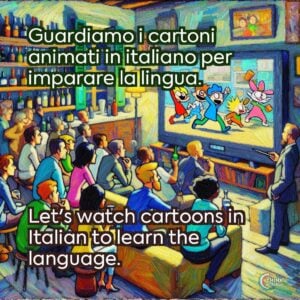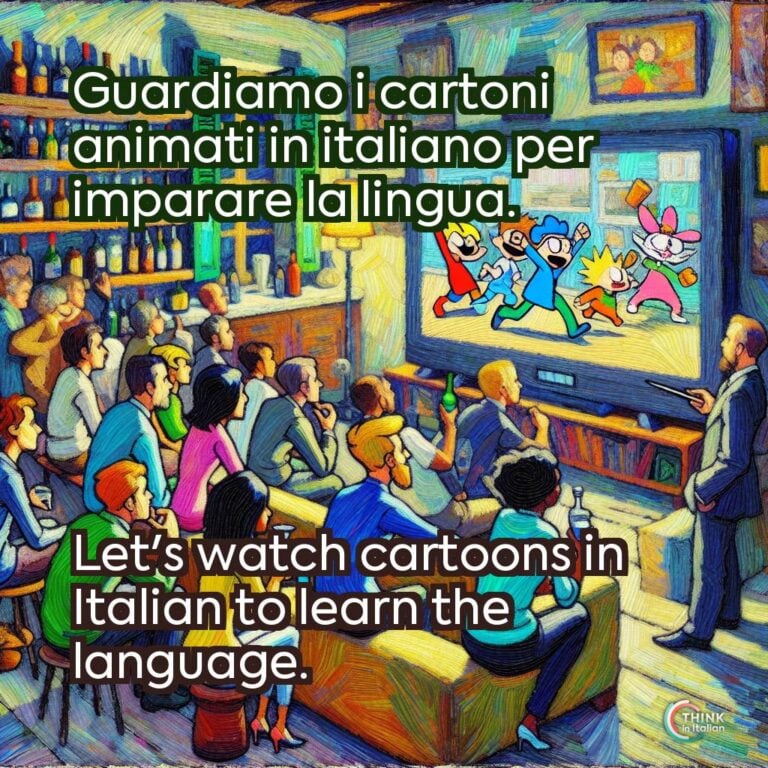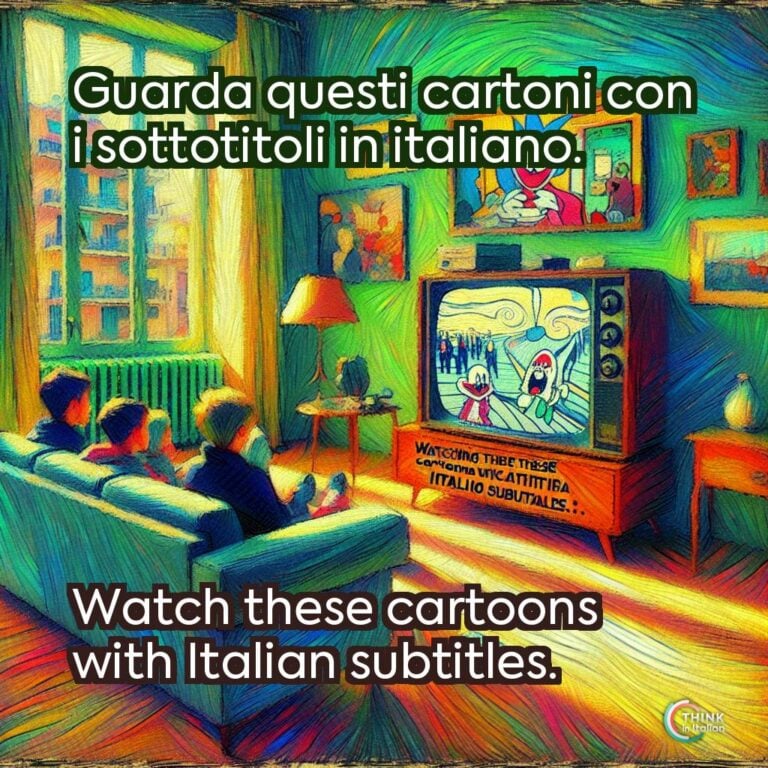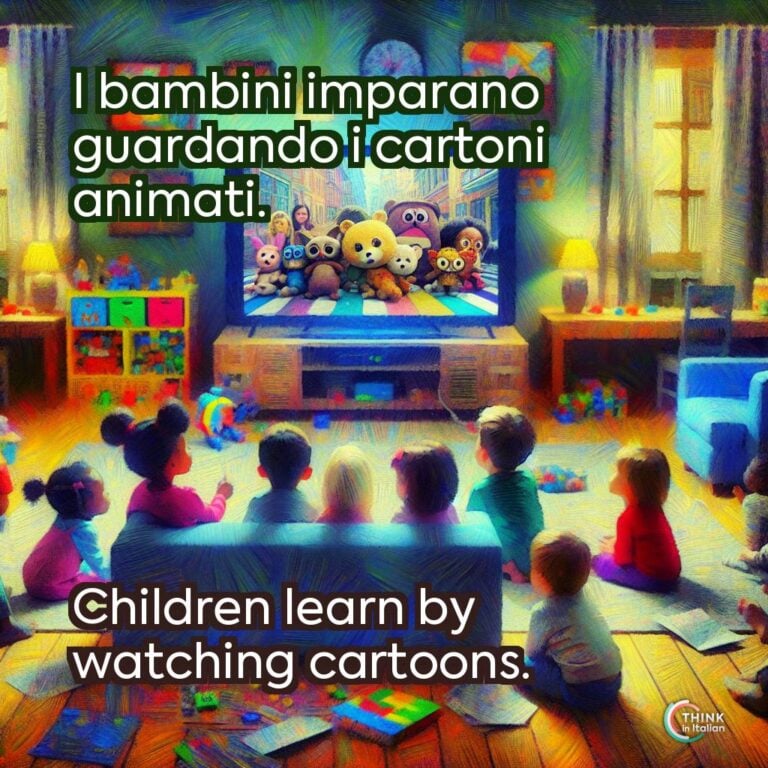Watching Cartoons to Learn Italian
Cartoons rely on bright visuals and exaggerated expressions, which allows for easier words association. Moreover, they use straightforward vocabulary, ideal for language learners: even complex words are explained in ways that are easy to understand.
The repetitive nature of cartoons is perfect to strengthen your vocabulary over time, as repetition naturally ingrains the language into your memory.
Another important aspect is that cartoons are fun to watch, which makes the learning process enjoyable and less intimidating. Learning Italian doesn’t have to be a chore!
Here, I will list you the best 10 cartoons to learn Italian, together with some tips to make use of this excellent language-learning tool.
Italian Cartoons
Biancaneve e i Sette Nani (Snow White and the Seven Dwarfs)
This Disney classic is a must-watch for its timeless story and beginner-friendly dialogue. The songs are perfect for picking up repetitive phrases and common vocabulary in a fun, musical way.
Dialogues often include polite forms and simple imperatives, like andiamo! (let’s go!) which are staples in everyday Italian.
Cenerentola (Cinderella)
The Italian adaptation of Cinderella showcases Disney’s classic charm with a magical flair. The vocabulary is clear and repetitive, especially in the scenes where Cinderella communicates with animals and her Fairy Godmother.
You’ll encounter descriptive adjectives like bellissima (very beautiful) and povero (poor) and learn how they’re naturally used in sentences.
I always find the transformation scene particularly mesmerizing in Italian, where Cinderella’s excitement is palpable, making it easier to connect emotionally to the language.
Bambi
If you want to cry, go for Bambi. It is ideal for beginners due to its slow pace and simple dialogue. The Italian diminutives, such as Tamburino (little drum), uccellino (little bird), and farfallina (little butterfly) introduce you to this common linguistic feature.
They are used to convey tenderness and affection, which are deeply embedded in Italian culture.
Il Re Leone (The Lion King)
This masterpiece combines drama and adventure with deep emotional resonance. The film introduces many verbs like correre (to run), saltare (to jump), and combattere (to fight), which are essential for describing movement.
Pinocchio
My favorite one since I was a child. Fun fact: I call my father babbo instead of papà specifically for Pinocchio! It Pinocchio is a cultural and linguistic goldmine.
The film uses conversational Italian that’s rich in everyday phrases, making it both relatable and educational. Expressions like non dire bugie (don’t tell lies) and sii bravo (be good) are staples of Italian parenting and showcase how language is used to teach values.
Il Libro della Giungla (The Jungle Book)
This adaptation of Kipling’s classic stories is packed with fun characters and memorable songs. Baloo’s playful tone and casual vocabulary are particularly helpful for learners aiming to grasp conversational Italian.
The film is great for learning idiomatic expressions like lasciati andare (let yourself go), which are common in everyday speech.
Topolino (Mickey Mouse)
Mickey Mouse brings relatable humor and practical scenarios to language learners. His short episodes are a treasure trove of simple, conversational Italian.
Mickey’s dialogues often include colloquial phrases like andiamo a vedere (let’s go see) and interjections like oh no! easy to memorize and use in real life.
La Regina delle Nevi (The Snow Queen)
Hans Christian Andersen’s tale of friendship and bravery comes alive in this adaptation. The dialogue is slow and expressive, perfect for beginners aiming to expand their emotional vocabulary.
You’ll pick up phrases related to emotions, like non aver paura (don’t be afraid) and credi in te stessa (believe in yourself). The Italian dubbing captures the poetic nature of the original story, making it a great choice for learners who enjoy lyrical language.
Il Vento Nei Salici (The Wind in the Willows)
This charming story of animal friends in the countryside offers a mix of slow-paced dialogue and rich descriptive language. It’s an excellent introduction to storytelling in Italian.
You’ll encounter nature-related vocabulary like fiume (river), albero (tree), and collina (hill), perfect for describing places and outdoors.
Peppa Pig
Peppa Pig is a top pick for absolute beginners. The short episodes, simple language, and slow pace make it ideal for building confidence in Italian.
Peppa’s daily activities introduce practical vocabulary like famiglia (family), tempo (weather), and scuola (school), all essential for everyday conversations. Watching Peppa interact with her family is not only fun but also a great way to pick up phrases you can use in real life.
Tips for Learning Italian with Cartoons
To maximize the benefits, use my tips:
- Start simple: begin with shows that have slow-paced dialogue and simple storylines. Options like Peppa Pig or Dora l’Esploratrice are perfect for beginners.
- Use subtitles wisely: start with Italian audio and subtitles to connect spoken words with their written forms. Gradually remove subtitles as your comprehension improves.
- Engage actively: keep a notebook for new words and phrases. Pause and replay scenes to clarify difficult expressions.
- Practice shadowing: mimic the characters’ speech to improve pronunciation and intonation.
By immersing yourself in Italian cartoons, you replicate the natural language-learning process of children. Through repetition, context, and visual cues, you memorize new vocabulary, improve pronunciation, and deepen cultural understanding.
So, grab some popcorn, pick a show from the list, and let the magic of cartoons guide you on your journey to fluency!






